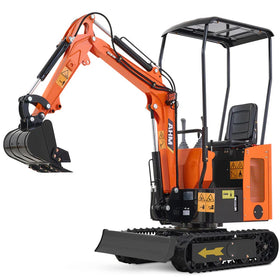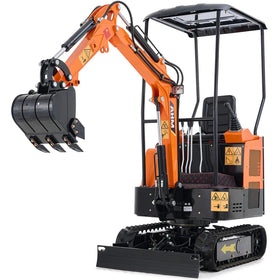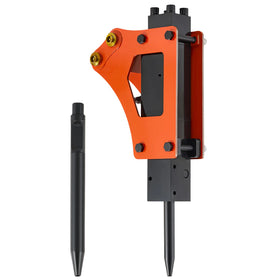Typically, a 1-ton mini excavator uses between 1-2 liters (0.26-0.53 gallons) of fuel per hour. Modern compact excavators like the Kubota K008-3 and Bobcat E10 run at around 2 liters per hour during regular operation. Some newer mini excavators equipped with smaller engines, like those with B&S and Kubota 13.5hp engines, can run efficiently at about 1 liter per hour.

1. Mini Excavator Fuel Consumption Rates by Task Type
Most days, your 1-ton mini excavators won't run at full throttle constantly. A typical workday mixes heavy digging with lighter tasks and some idle time. This means your actual fuel consumption often ends up lower than the max rates manufacturers quote.
Let's break down real-world consumption:
- Light work (grading, shallow digging): About 1 liter/hour or 0.26 gal/hour
- Medium work (utility trenching): 1.5 liters/hour or 0.4 gal/hour
- Heavy work (hard soil, constant operation): Up to 2 liters/hour
2. Daily Fuel Costs Breakdown
Let’s say you were running a 1-ton mini excavator for an 8-hour day. Let's do the math with current diesel prices hovering around $4 per gallon. Say you're doing a mix of work throughout the day:
- Morning: 3 hours of steady digging (1.5L/hour)
- Midday: 2 hours of light finishing work (1L/hour)
- Afternoon: 3 hours of moderate trenching (1.5L/hour)
Total daily consumption would be around 11 liters (about 2.9 gallons). At $4/gallon, you're looking at roughly $11.60 in fuel costs for a full day's work. Pretty manageable compared to larger machines, right?

Most 1-ton mini excavators come with a fuel tank capacity of 8-15 liters (2.12-4 gallons). With typical consumption rates of 1-2 liters per hour, operators can expect 6-8 hours of continuous operation from a full tank under normal conditions. For an average workday, this means most operators will need to refuel every 1-2 days, depending on work intensity and duration.
3. How to Reduce Mini Excavator Fuel Consumption
You don't need fancy techniques to save fuel - just some practical habits:
Get your timing right.
If you can, schedule heavy digging for cooler morning hours. Your engine won't have to work as hard, and you'll burn less fuel. Plus, it's a lot more comfortable for you too.
Watch your idle time.
Modern 1-ton minis are pretty fuel-efficient when running, but even small engines waste fuel when idling. Make it a habit to shut down during those longer breaks.
Keep an eye on maintenance.
Clean air filters and proper oil levels make a big difference in fuel consumption. Many folks overlook these basics until their fuel costs start creeping up.
4. How Engine Size Affects Mini Excavator Fuel Usage
Let's compare different engine sizes and what they mean for your fuel bills. A 13.5hp engine sips about 1L/hour while a 23hp unit drinks around 1.5L/hour. Sounds simple, but here's the real deal:
Smaller Engines (13.5hp)
These are perfect for precision work like backyard projects or tight-space utility work. They're fuel-efficient at 1L/hour, but they'll need to work harder in tough conditions, like driving a compact car - great on gas until you load it up with passengers and cargo.

Mid-Range Engines (23hp)
At 1.5L/hour, these give you more muscle when you need it. The 23 hp mini excavators handle tough soil better without straining, which can actually save fuel in the long run. It's like having a V6 instead of a 4-cylinder - sometimes that extra power means you're not pushing the engine to its limits.
5. Seasonal Fuel Use Reality Check
Summer Heat
When temperatures soar, your mini excavator's going to work harder to stay cool. Expect to use about 10-15% more fuel during those scorching summer afternoons. Just like your car's AC eating up more gas in summer, your excavator's cooling system needs more energy to keep things running smoothly.
Winter Operations
Until everything warms up properly, cold starts and thick hydraulic fluid can bump up fuel use by 20%, according to the Department of Energy's Alternative Fuels Data Center. Give your machine those extra few minutes to warm up - it'll save you fuel in the long run and protect your investment.
6. Tracking Your Fuel Efficiency
The most reliable way to track efficiency is keeping a simple fuel log. Record how much fuel you add and the hours on your machine's meter. After a few weeks, you'll have solid data showing your actual consumption rates.
Common Signs of Declining Fuel Efficiency
When you notice your machine using more fuel than usual, it often indicates underlying issues. For example, if your typical 1L/hour consumption suddenly increases to 1.3L/hour, it might signal problems with:
- Clogged air or fuel filters reducing engine efficiency
- Worn hydraulic components requiring more power
- Engine timing issues affecting combustion efficiency
Comparing with Larger Excavators
To put these consumption rates in perspective, a 1-ton mini excavator's fuel efficiency becomes quite apparent when compared to larger machines. While most 1-ton mini excavators use 1-2L/hour, standard 3-ton excavators typically consume 3-4L/hour, and larger 5-ton machines use 5-6L/hour or more.
This efficiency makes 1-ton mini excavators particularly cost-effective for projects where larger equipment isn't necessary. The key is matching the machine size to your typical workload. For residential projects, utility work, and landscaping, the fuel consumption rates of 1-ton excavators strike an optimal balance between capability and operating costs.
7. Operating Conditions Impact on Fuel Economy
The terrain type significantly influences fuel usage - working in loose soil might maintain the baseline 1-1.5L/hour consumption rate, while rocky or compacted ground can increase fuel usage by up to 25%. Similarly, operating on slopes requires more power, potentially pushing consumption toward the upper range of 2L/hour even for routine tasks.

Job site layout also plays a crucial role in fuel efficiency. When excavators need to swing frequently or travel longer distances between dig sites, fuel consumption typically increases. Planning your work zone to minimize machine movement can help maintain optimal fuel usage rates within the standard 1-2L/hour range.
8. Optimizing Work Patterns for Fuel Efficiency
Your work patterns can directly impact fuel consumption. Starting with lighter tasks allows the machine to warm up gradually, optimizing fuel usage during the critical first hour of operation. When transitioning between tasks, maintaining a steady workflow rather than frequent stops and starts helps keep fuel consumption closer to the efficient 1L/hour rate rather than pushing toward the maximum 2L/hour consumption.

9. Frequently Asked Questions
1) How much fuel does a mini excavator use per day?
A 1-ton mini excavator typically uses 8-12 liters (2.1-3.2 gallons) during an 8-hour workday, depending on the type of work performed. This translates to approximately $10-15 in daily fuel costs at current prices.
2) Does engine size significantly affect fuel consumption?
Yes, engine size directly impacts fuel usage. 13.5hp engines average 1L/hour for light work, while 23hp engines consume around 1.5L/hour but provide more power for demanding tasks.
3) How do seasonal changes affect mini excavator fuel consumption?
Summer operations can increase fuel consumption by 10-15% due to increased cooling demands, while winter operations may require up to 20% more fuel during warm-up periods and when hydraulic fluid is cold.
4) What's the fuel consumption difference between mini and standard excavators?
While 1-ton mini excavators use 1-2L/hour, 3-ton machines typically consume 3-4L/hour, and 5-ton excavators use 5-6L/hour or more, making mini excavators more economical for smaller projects.
5) How can I monitor my mini excavator's fuel efficiency?
Track fuel consumption by maintaining a log of fuel added and operating hours. A sudden increase from the typical 1L/hour to 1.3L/hour or more may indicate maintenance needs or operational issues.







